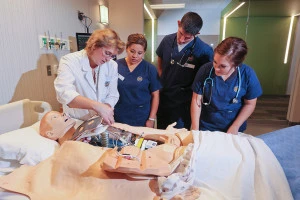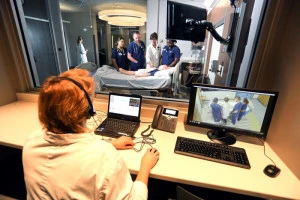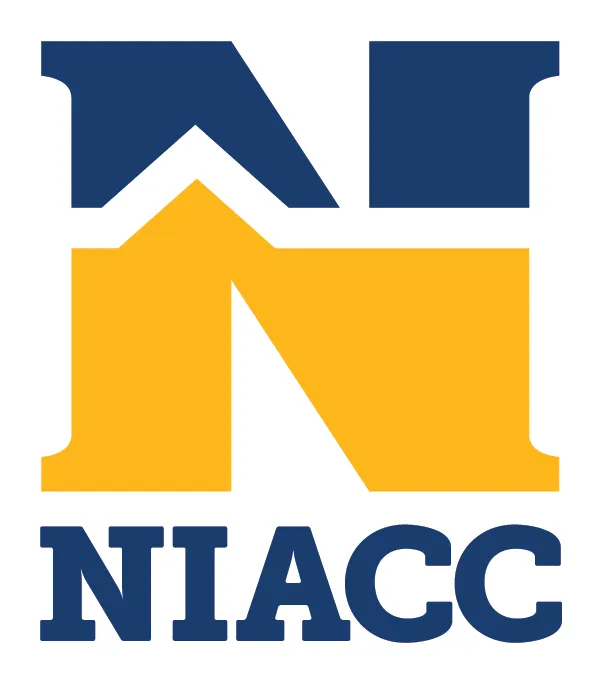The Health Simulation Center (HSC), which is located in McAllister Hall on the main NIACC campus, is utilized by the NIACC Health programs as well as Continuing Education courses. The HSC is a state-of-the-art four room facility with adjoining control rooms that provides a realistic, simulated clinical learning environment for students. The four simulation rooms provide a safe place for students to practice high-level skills and situations they otherwise would only encounter in the live client environment. This allows them time to plan, implement and evaluate their actions and decisions related to client care.
The adjoining control rooms are where faculty can directly visualize and respond immediately to the student interactions with the client or manikin. The control room is where faculty adjust the manikin’s physiology in response to student actions, run the audio/video system and respond to students as the voice of the manikin.
 The HSC houses six high fidelity manikins or simulators: SimNewB, SimJunior, SimMan 3G, SimMan Essential, SimBaby and SimMom. These life-like manikins have realistic lung, heart and bowel sounds, chest rise and fall to simulate breathing. The newest manikin can also give birth. The manikins provide access to a wide age-range of clients to care for from the newborn to the elderly. The manikins are essential for student scenarios and learning activities and are utilized with other state-of-the-art medical equipment to support student learning.
The HSC houses six high fidelity manikins or simulators: SimNewB, SimJunior, SimMan 3G, SimMan Essential, SimBaby and SimMom. These life-like manikins have realistic lung, heart and bowel sounds, chest rise and fall to simulate breathing. The newest manikin can also give birth. The manikins provide access to a wide age-range of clients to care for from the newborn to the elderly. The manikins are essential for student scenarios and learning activities and are utilized with other state-of-the-art medical equipment to support student learning.
There are four classrooms with the latest technology connected to the center. A sophisticated audio/video system provides observers with a live video feed of the simulation room to these classrooms to allow those not participating directly to observe the simulation. This system also records the simulation so participants can later view the simulation experience for learning during debriefing.
Vision Statement
The NIACC Health Simulation Center will provide realistic simulation experiences for Health and Continuing Education students through the use of state-of-the-art equipment and technology. Students will practice clinical skills in a realistic environment with the intended outcome of improving overall quality of client care and improving the student’s confidence and competency of practice in the clinical area.
Mission Statement
The Mission of the NIACC Health Simulation Center is to provide evidence-based, experiential learning opportunities for our Health program students, faculty and the community using our state-of-the-art technology and best practices in a supportive and controlled setting.
The Use of Simulation
 Simulation experiences are a component of many of the NIACC Health programs and Continuing Education courses. Simulation is utilized as an alternative learning environment for students. Students are able to simulate a client care experience in a nonthreatening setting and see how the consequences of their actions or inactions affect client care based on their clinical judgment. Students are able to prepare for the scenario with content-expert faculty in prebriefing, participate in simulation and finally evaluate and process their performance in video-based debriefing sessions. Scenarios utilized in the HSC are built from high-risk, low-incidence situations encountered in the clinical area that faculty want to guarantee all students have exposure to prior to completion of the course or programs.
Simulation experiences are a component of many of the NIACC Health programs and Continuing Education courses. Simulation is utilized as an alternative learning environment for students. Students are able to simulate a client care experience in a nonthreatening setting and see how the consequences of their actions or inactions affect client care based on their clinical judgment. Students are able to prepare for the scenario with content-expert faculty in prebriefing, participate in simulation and finally evaluate and process their performance in video-based debriefing sessions. Scenarios utilized in the HSC are built from high-risk, low-incidence situations encountered in the clinical area that faculty want to guarantee all students have exposure to prior to completion of the course or programs.
 |
 |
